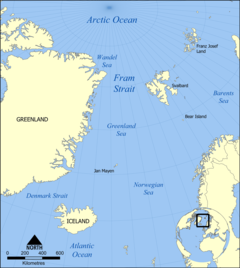Odden ice tongue
| Greenland Sea | |
|---|---|

Greenland Sea iceberg
|
|
 |
|
| Coordinates | 76°N 8°W / 76°N 8°WCoordinates: 76°N 8°W / 76°N 8°W |
| Type | Sea |
| Basin countries | Greenland, Iceland, Norway |
| Surface area | 1,205,000 km2 (465,300 sq mi) |
| Average depth | 1,444 m (4,738 ft) |
| Max. depth | 4,846 m (15,899 ft) |
| Water volume | 1,747,250 km3 (419,000 cu mi) |
| References | |
The Greenland Sea is a body of water that borders Greenland to the west, the Svalbard archipelago to the east, Fram Strait and the Arctic Ocean to the north, and the Norwegian Sea and Iceland to the south. The Greenland Sea is often defined as part of the Arctic Ocean, sometimes as part of the Atlantic Ocean. However, definitions of the Arctic Ocean and its seas tend to be imprecise or arbitrary. In general usage the term "Arctic Ocean" would exclude the Greenland Sea. In oceanographic studies the Greenland Sea is considered part of the Nordic Seas, along with the Norwegian Sea. The Nordic Seas are the main connection between the Arctic and Atlantic oceans and, as such, could be of great significance in a possible shutdown of thermohaline circulation. In oceanography the Arctic Ocean and Nordic Seas are often referred to collectively as the "Arctic Mediterranean Sea", a marginal sea of the Atlantic.
The sea has Arctic climate with regular northern winds and temperatures rarely rising above 0 °C. It previously contained the Odden ice tongue (or Odden) area, which extended eastward from the main East Greenland ice edge in the vicinity of 72–74°N during the winter and acted as a key winter ice formation area in the Arctic. The West Ice forms in winter in the Greenland Sea, north of Iceland, between Greenland and Jan Mayen island. It is a major breeding ground of harp seal and hooded seal that has been used for seal hunting for more than 200 years.
...
Wikipedia
